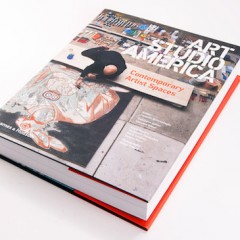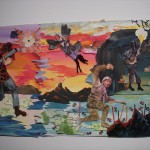Without Boundary — closing soon (May 22) at MoMA — is an exhibition chock full of great work. I saw it last month when Steve and I were on our Three Penny Opera trip. Some of the art and artists in the show I knew, like Shahzia Sikander, Kutlug Ataman, Emily Jacir, Marjane Satrapi. I’d seen their works in Philadelphia and elsewhere (Sikander’s at the Fabric Workshop and elsewhere, Jacir at the Whitney Biennial 2004, Ataman’s at the Carnegie International 2004 and Art at the Armory.) Others, like Satrapi’s Persepolis, is a graphic novel I own. Libby and I have written about many of these artists’ works. You’ll find their names in our index.
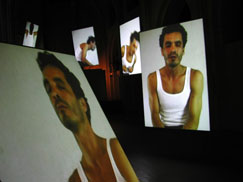
Kutlug Ataman, 99 Names, 5-channel video installation. This piece, by the way, is on the 2nd floor, separated from the rest of the show. Don’t miss it–it’s best of show in my book.
I was happy to see all the work together although as I read the catalog essay by the show’s curator, MoMA Assistant Curator Fereshteh Daftari, I began to wonder about the premise for the whole thing. Daftari makes much of the term “Islamic” in her essay. She’s all about how the label is wrong-headed when applied to artists like these who come from various backgrounds and make work that has less to do with religion than with personal expression about the part of the world they live in.
She’s right, the work shouldn’t be gulaged as Islamic. Any labelling is counterproductive although we all are prone. Labelling is human shorthand to help organize the world. It’s how you label that’s all important.
But wait a minute. Without Boundaries is a show that features a lot of Arabic script, ideas about the burka-ing of woman, ideas about prayer rugs, prayer and mysticism. and it brings all this work together so that it can NOT be labelled or gulaged as Islamic art. Isn’t the exhibit itself a kind of a gulag?

Jananne Al-Ani, Untitled 1 and 2, 1996, two gelatin silver prints, each 47 1/4′ x 70 7/8″
I’ve always thought works by these artists are iconoclastic. That’s the label I would give them. When I’ve seen works by Sikander, Ataman and others presented in group shows that focus on a global context I never would have said these artists are making Islamic art. They of course use the trappings of culture and religion and twist and subvert them. But they’re questioning dogma or questioning the rote acceptance of any cultural or religious dictate. They are making deeply personal works in a global context.
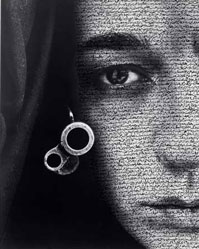
Shirin Neshat, Speechless, 1996, RC print and ink, 66″ x 52 1/2″
So let’s talk for a moment about niche museums. I’ve always had problems with The National Women’s Art Museum in DC and the African American Museum in Philadelphia. I understand the need for these institutions: They are empowerment museums and grow out of frustration with a mainstream museum culture that doesn’t show or collect enough works by women and artists of color. But doesn’t an alternative museum structure let the big institutions keep on doing what they’re doing? Isn’t it just segregating the art? Didn’t we decide once after heated battle on the subject that separate is not equal?
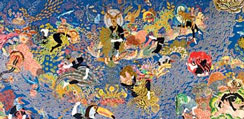
Raqib Shaw’s The Garden of Earthly Delights III, 2003. mixed media on board, 3 panels, 10′ x 15′. Stunning marriage of Indian miniature painting and Bosch.
My best of show in Without Boundary is Kutlug Ataman’s “99 Names” a hallucinatory multi-screen video installation in which a man rocks himself back and forth in a frenzy of wordless, eyes-closed motion as if blocking out the world and trying to escape into some place where it is safe and peaceful. I thought the work was scary, beautiful, and was itself a rhythmic incantation for all of us to get to a peaceful place to back out of this hole we’re in with war and the “clash of cultures.”
Speaking of clash of cultures, Steve and I saw Amartya Sen, Harvard Professor of Economics and Nobel Prize winning activist at the Free Library in April. Sen gave a talk that included this major point, which I hadn’t heard before and which shocked me: Multiculturalism, he said, is just monoculturalism gone nuts (I’m paraphrasing), each group embracing its own culture in a kind of cult of separatism masquerading as something more benign. Monocultural separatism has brought us a pre-emptive war, he said. And we must stop thinking in these ungenerous separatist ways.
I’m sure many of you have thoughts about this too. It’s a big issue. By the way, MoMA has a very good audio slide show of the exhibit on their website. Here.


